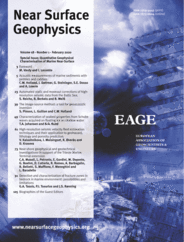-
oa Automated static and moveout corrections of high‐resolution seismic data from the Baltic Sea
- Source: Near Surface Geophysics, Volume 18, Issue Issue 1 - Quantitative Geophysical Characterisation of Marine Near‐Surface, Jan 2020, p. 23 - 37
-
- 28 Apr 2019
- 29 Aug 2019
- 29 Oct 2019
Abstract
High‐frequency multichannel seismic systems provide detailed images of the shallow marine subsurface. In order to exploit the redundancy inherent in such data optimally, traveltime corrections need to account for normal moveout and static effects due to vertical source and receiver variations. Misalignment of reflections in common‐midpoint gathers will significantly lower the frequency content in the final stack, making this correction particularly important for very high‐frequency seismic data. Traditionally, normal moveout correction involves labour‐intensive picking of stacking velocities, while static corrections can be, by some techniques, performed automatically. In this paper, we present a high‐frequency seismic case study from the Baltic Sea, using seismic image matching as a novel, fully automated technique to perform joint moveout and static corrections. Our multichannel test profiles were acquired offshore Rügen island for wind farm development. Owing to the regular passage of up to 1.5 m high ocean waves during data acquisition, these boomer profiles suffer from strong static effects. We perform joint normal moveout and static corrections by defining the nearest common offset section as a fixed reference frame and minimizing its difference in traveltime with respect to all available common offset sections. Time shifts are computed independent of a pre‐defined traveltime curve, using the normalized cross‐correlation as a measure of data similarity while penalizing irregular displacements by a regularization term. Time shifts are converted to stacking velocities based on the traditional hyperbolic traveltime equation. Our results are compared with those derived by conventional manual velocity analysis and subsequent trim static corrections. We find that image matching produces stacks of similar quality and stacking velocity models of similar to slightly better quality compared with the conventionally derived ones, revealing the potential of this technique to automatize and significantly speed up this first part of the seismic processing chain.



